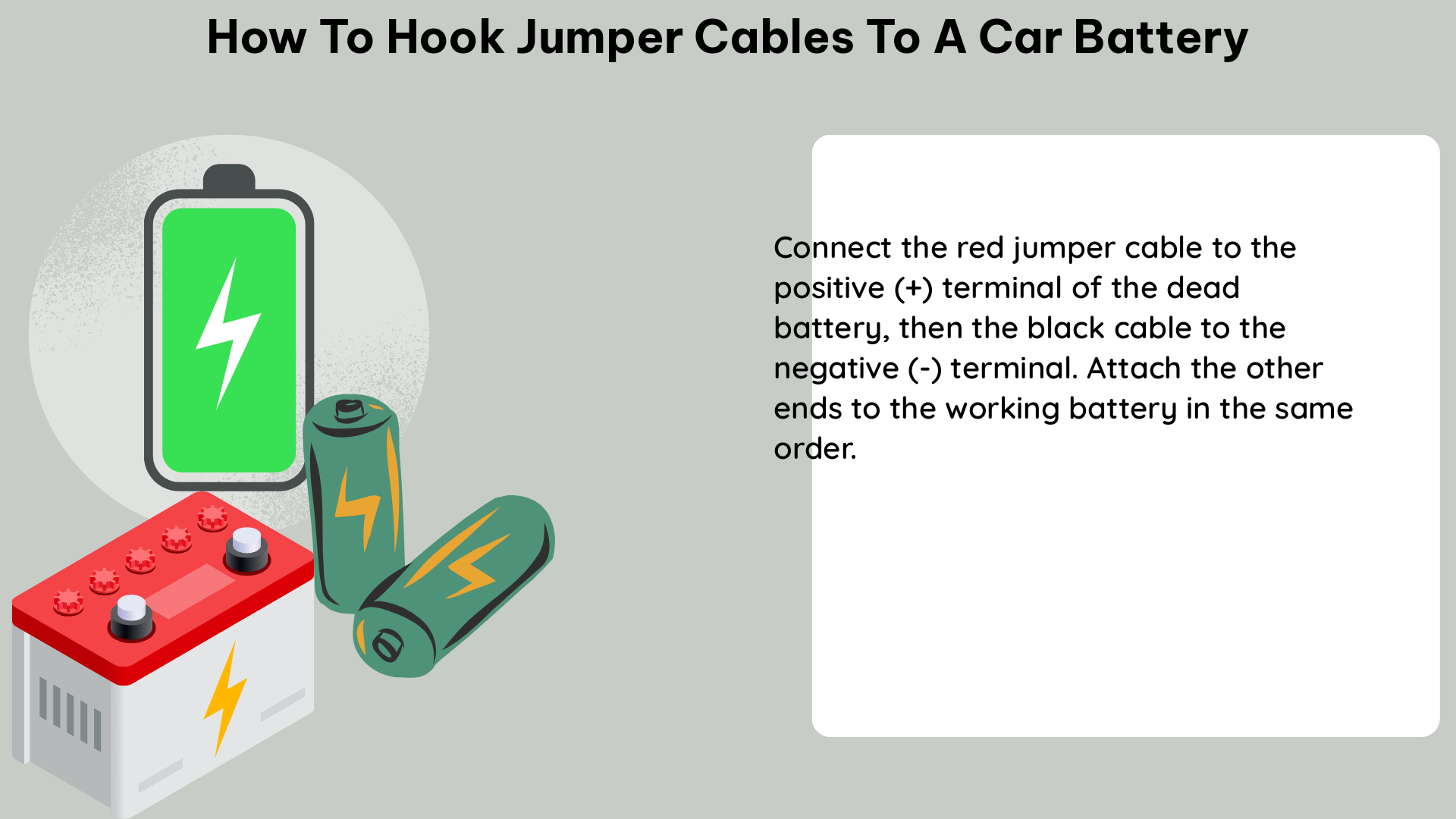Jumping a car battery is a common task that many drivers will need to perform at some point. Knowing the proper way to connect jumper cables can help ensure a safe and successful jump-start. This comprehensive guide will walk you through the step-by-step process of hooking up jumper cables to a car battery, providing detailed technical specifications and best practices to follow.
Preparing for the Jump-Start
Before you begin, make sure you have the necessary equipment:
-
Jumper Cables: Jumper cables typically measure around 6 to 8 feet in length and have heavy-duty clamps on each end. The cables should be made of thick, copper-coated wire to handle the high current required for a jump-start.
-
Two Vehicles: You’ll need one vehicle with a good, fully charged battery (the “donor” car) and one vehicle with a dead battery (the “recipient” car).
-
Protective Gear: It’s recommended to wear safety glasses and gloves when working with car batteries to protect yourself from potential sparks or acid spills.
Step-by-Step Guide to Hooking Up Jumper Cables

-
Park the Vehicles: Position the two vehicles close enough for the jumper cables to reach, but make sure they are not touching. Engage the parking brakes on both cars to prevent any accidental movement.
-
Identify the Battery Terminals: Locate the positive (+) and negative (-) terminals on both the donor and recipient car batteries. The positive terminal is typically marked with a “+” symbol, while the negative terminal is marked with a “-” symbol.
-
Connect the Positive Cable: Start by connecting the positive (red) jumper cable clamp to the positive (+) terminal of the dead battery in the recipient car. Ensure the connection is secure and tight.
-
Connect the Other Positive Cable End: Next, connect the other end of the positive (red) jumper cable to the positive (+) terminal of the good battery in the donor car.
-
Connect the Negative Cable: Connect the negative (black) jumper cable clamp to the negative (-) terminal of the good battery in the donor car.
-
Ground the Negative Cable: Finally, connect the other end of the negative (black) jumper cable to an unpainted metal surface on the recipient car, such as an engine bolt or the vehicle’s frame. Avoid connecting it directly to the negative battery terminal or any fuel system components.
Note: It’s crucial to connect the jumper cables in the correct order to prevent sparks or potential damage to the electrical systems.
-
Wait a Few Minutes: After connecting the jumper cables, wait for a few minutes (typically 2-3 minutes) before attempting to start the recipient car. This allows the good battery to begin charging the dead battery.
-
Start the Recipient Car: Try to start the car with the dead battery. If it doesn’t start immediately, let the engines run for a few more minutes before trying again.
-
Run Both Vehicles: Once the recipient car is running, let both vehicles run for about 3-5 minutes with the jumper cables still connected. This allows the dead battery to receive a sufficient charge.
-
Disconnect the Jumper Cables: Carefully disconnect the jumper cables in the reverse order: first the negative (black) cable from the recipient car, then the negative (black) cable from the donor car, followed by the positive (red) cable from the donor car, and finally the positive (red) cable from the recipient car.
-
Run the Recipient Car: After disconnecting the jumper cables, it’s recommended to let the recipient car run for at least 30 minutes to allow the battery to fully recharge. Avoid turning off the engine during this time.
Additional Tips and Considerations
-
Cable Length: Jumper cables typically range from 6 to 8 feet in length, but longer cables (up to 20 feet) are available for situations where the vehicles are parked farther apart.
-
Cable Gauge: The thickness or gauge of the jumper cables is important. Thicker cables (lower gauge numbers, such as 4 or 6 gauge) can handle higher currents and are better suited for jump-starting larger vehicles or trucks.
-
Battery Condition: If the recipient car’s battery is severely discharged or damaged, a jump-start may not be enough to fully restore it. In such cases, the battery may need to be replaced.
-
Safety Precautions: Always exercise caution when working with car batteries, as they can produce explosive hydrogen gas. Avoid sparks, flames, or smoking near the battery, and ensure proper ventilation.
-
Alternator Charging: After a successful jump-start, the recipient car’s alternator should continue charging the battery while the engine is running. However, it’s still a good idea to drive the car for at least 30 minutes to ensure the battery is fully recharged.
By following these detailed steps and considerations, you can safely and effectively jump-start a car with a dead battery using jumper cables. Remember to always prioritize safety and consult your vehicle’s owner’s manual for any specific instructions or recommendations.
References
- How to Jump-Start a Car Battery
- Jump-Starting and Charging a Car Battery
- How to Jump-Start a Car Battery

The lambdageeks.com Core SME Team is a group of experienced subject matter experts from diverse scientific and technical fields including Physics, Chemistry, Technology,Electronics & Electrical Engineering, Automotive, Mechanical Engineering. Our team collaborates to create high-quality, well-researched articles on a wide range of science and technology topics for the lambdageeks.com website.
All Our Senior SME are having more than 7 Years of experience in the respective fields . They are either Working Industry Professionals or assocaited With different Universities. Refer Our Authors Page to get to know About our Core SMEs.